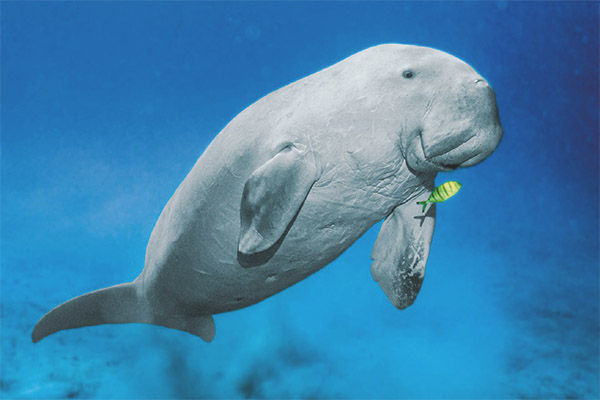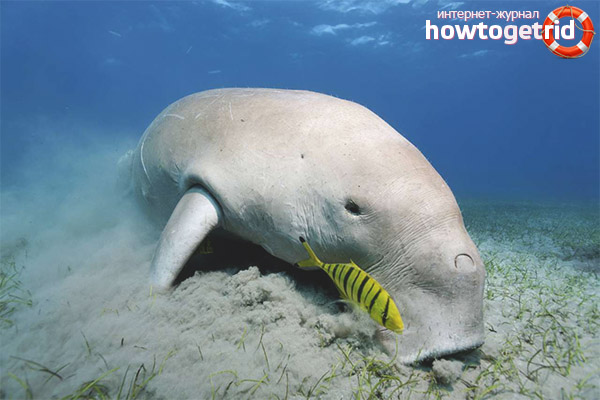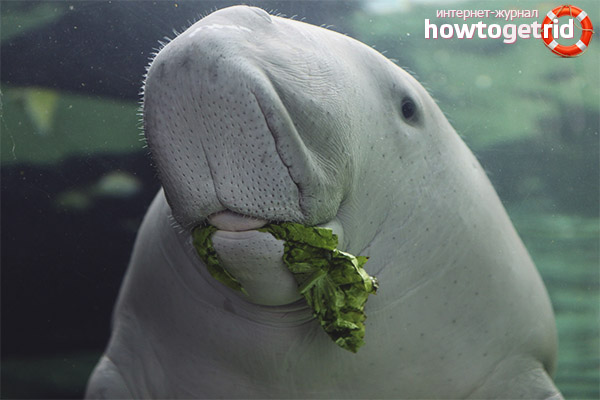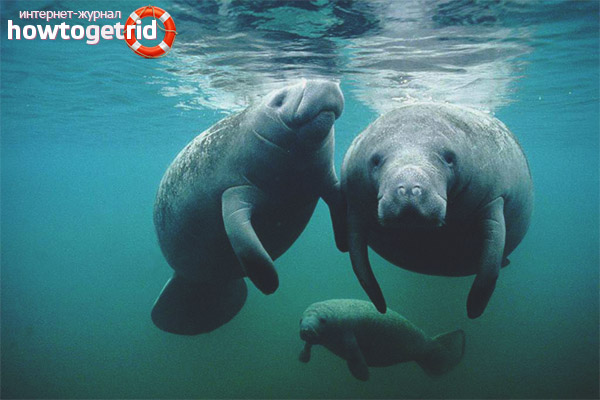The content of the article
Dugongs are enchanting sea creatures; they are herbivorous mammals and most resemble sea cows. Actually, they are quite close to manatees, which are called sea cows. Zoologists attribute dugongs to the order of sirens. Just so, there is such a detachment, which is called a word from ancient Greek legends, moreover, duyung is translated from the Malay language as a mermaid or a maiden from the sea.
In Russia, the dugong is often referred to as the sea cow, because the mermaid, such as the Russian epic describes this creature, is still far away, lacks grace. But if you compare with a cow, then the dugong is quite consistent with this animal. He also has a massive body, awkwardness and some kind of soft charm that makes you be touched and rejoice in the habits of this magnificent sea creature.
Basic information
For the most part, dugongs prefer to settle along the shores, where the seas and oceans form coves and shallow lagoons. Now the area is a tropical belt of the Pacific and Indian Oceans. As it is not difficult to understand, they live in spaces of sea water and practically do not swim into fresh water.
They are the smallest of the representatives of the order of sirens, since with a body length of four meters they weigh only up to 600 kilograms, and this ratio for such animals is quite moderate. Moreover, males are always larger than females.
The structure of the body is a kind of cylinder, which has many folds, characteristic for all owners of thick skin and an essential layer of subcutaneous fat.
The skin really has an impressive thickness - about two centimeters or more, and the color is grayish with a slight gradient. Always the belly is lighter, and the back is slightly darker.
Outwardly, the dugong would be easily confused with the manatee, if not for the hind fin, which, unlike the manatee, is divided by a deep hollow in the middle, and most of all resembles a whale. For comparison, the back fin of the manatee is shaped like a paddle or a paddle similar to the manatee fin, as you like.
We now turn to the description of the face of the dugong, which also deserves some attention and is distinguished by its characteristic features. The auricles are absent in a typical way in many sea creatures, and the eyes deep in the sockets are also suitable for dwelling under water (by the way, at the same time they hear perfectly well, but see so-so).The head is relatively small in size compared to the body and is sedentary. The muzzle has fleshy sponges and a blunt nose, which is supplied with a valve that closes the internal space from external water.
The nature and lifestyle of the dugong
These aquatic mammals in their peace and slowness are like cows, and if described more accurately, they are fearful cows. It would seem that the water space is native to the dugong, so why not feel confident and even a little imposing? However, they look rather timid, move carefully and smoothly. The distance, which dugong overcomes in an hour, is on average approximately 10 kilometers. On the other hand, dugongs do not need sprint abilities, quite the contrary - it is precisely this slowness and measuredness that in many respects makes it possible to be effective in the search for food.
For dugongs, the main occupation is the search for various plants, i.e., algae that spread along the seabed. Therefore, they swim over the seabed like this and calmly eat algae - why not sea cows?
Oddly enough, these shy animals are not particularly prone to flocks. For the most part they are individual farmers and the formation of the flock, as a rule, is caused only by the presence of vegetation on some territory. Then the dugongs gather in a small group of five or a little more individuals, and smoothly run through a separate location, as if in a group doing food gathering.
In addition, there is the possibility of group migration, when the whole population goes to warmer regions in order to search for food. Such migrations are determined by the choice of more preferred climatic conditions.
Another oddity is total favor with the people. If you’ve ever seen a cute and pliable pet, the dugong is an example of the cutest and pliable of them. Sea giants allow themselves to squeeze, stroke, hug, caress, kiss, photograph, do so that it is more convenient to pose. They can be scratched, massaged and much more. Therefore, quite often, when you look for a photo of a dugong on the Internet, then there will certainly be some person there who is squeezing a sea cow or doing something funny with this animal. Actually, the dugong is not particularly against such communication.
The secret of this behavior lies in the thick skin, which makes these creatures almost completely invulnerable to external influences. Predators do not pay much attention to the dugong at all, because trying to get that kind of skin is more expensive. Both dugongs and predators understand this fact, and therefore do not interfere with each other and generally do not overlap. Sometimes, of course, it happens that a shark may want to feast on a baby sea cow, but with the advent of the mother the predators retire. Dugongs are able to drive away even huge sharks, which also see no point in trying their hand with these giants.
Dugong food
If you look at the plump lips of these creatures, then the upper lip stands out quite clearly, which without exaggeration looks just huge. This detail also allows to tear off plants from a sea bottom. The daily diet of an adult animal may be about 40 kilograms of various sea grass and various algae.
Males have a small advantage compared to dugong females, as they have upper teeth - tusks, which are used, among other things, to scoop out plants from the bottom.They dig quite long grooves and along these paths it is easy to track where the dugong was grazing and where it was heading.
The days of the dugong are pretty monotonous and measured, given the amount of food they need to collect, they are just that. First, they float around the bottom for about 15 minutes, then float up and gain air, and again to the bottom. So days replace weeks, and weeks change years, and sea cows continue to graze along the bottom of the sea, leaving behind two long furrows as original time lines that are washed away by the waters of eternity.
At the same time, dugongs are not stupid animals, on the contrary, they know how to store food for the future and generally show some ingenuity. Often, a supply of algae is collected in a separate location, from where the dugong can then take the required amount and free themselves from collecting for a period.
Reproduction and longevity
In the tenth year of its existence, the dugong becomes an adult creature and can begin to mate. Moreover, dugongs are able to indulge in this activity at any time of the year, since they are not conditioned by the framework of the reproduction period determined by nature. In general, they mate throughout the year.
Such freedom, however, does not cancel the difficulties in the struggle for the female. In order to get intimacy with his darling, the male is often faced with a fight with his opponent on the tusks. The dugongs use their upper teeth quite skillfully and can inflict significant damage on an opponent.
In fact, the outcome of the fight and decides a further breeding option. The winner of the fight leaves almost immediately after this with a female and is engaged in conceiving a new dugong. After that, the males retire and do not engage in their own offspring.
Gradually, the baby grows up and begins an independent existence, which is quite long.The dugong's age reaches 70 years or more, if external factors do not affect it. By external factors, we mean mainly human, which significantly affects the population of these animals.
At this time, the dugong population is rather small, people in the 20th century influenced these animals in the most negative way. Now fishing with nets is prohibited, and dugongs are protected by various international organizations. Only harvested using harpoons within small nations and cultures that historically use dugongs to maintain their own existence and are engaged in a reasonable catch of these animals is allowed.
Video: Dugong (Dugong dugon)














To send